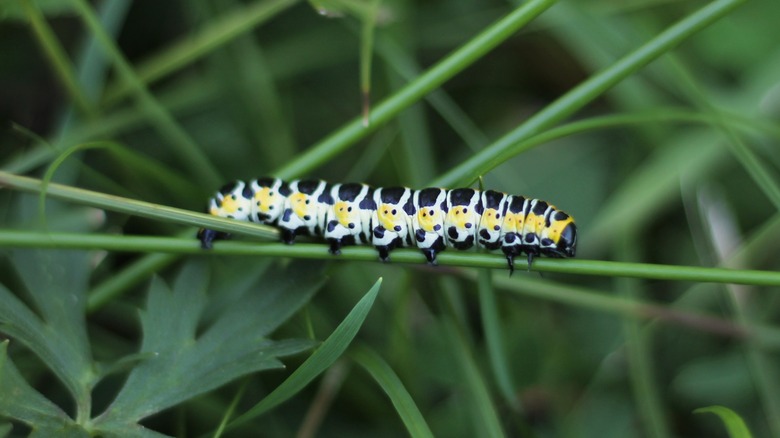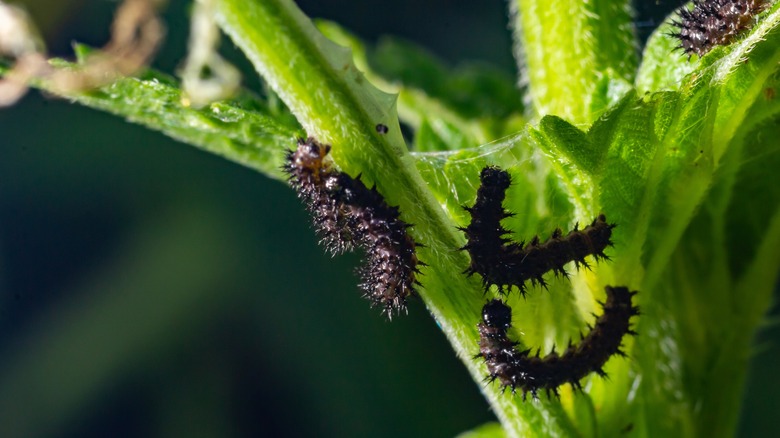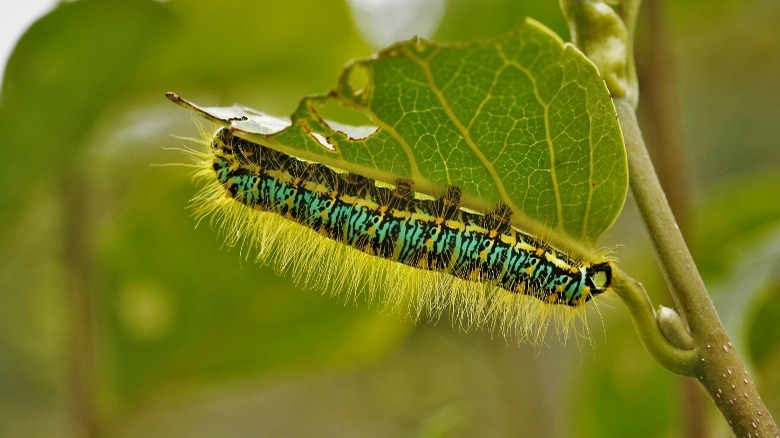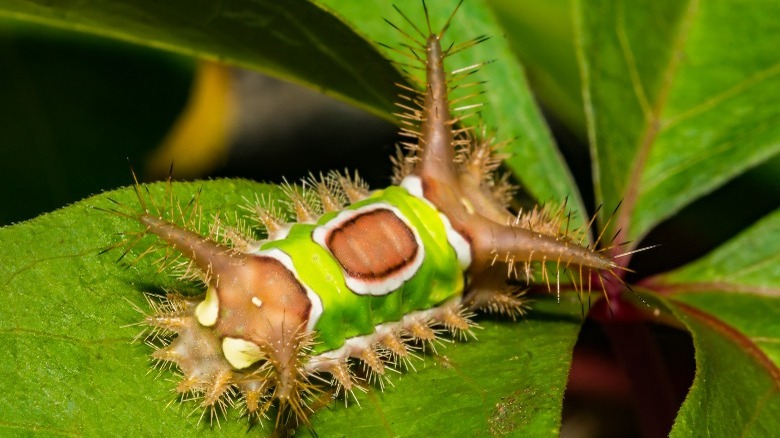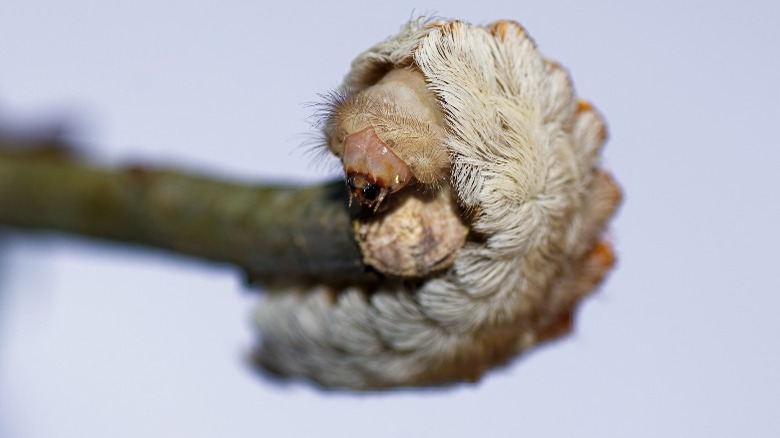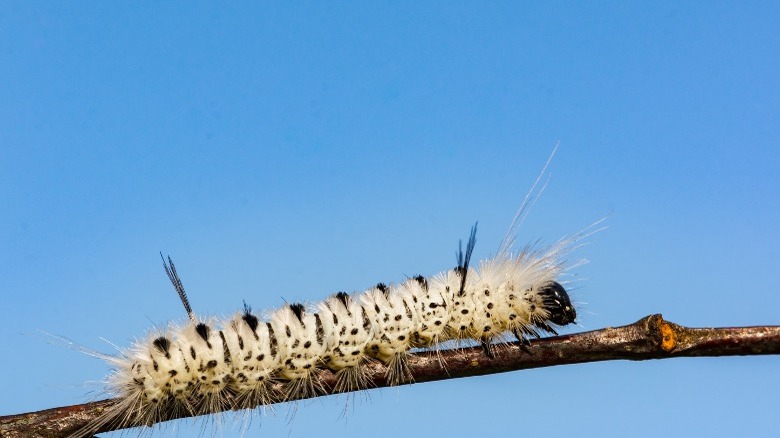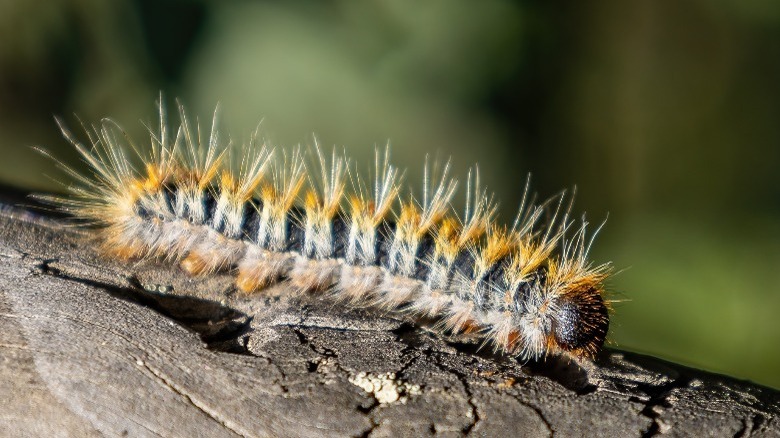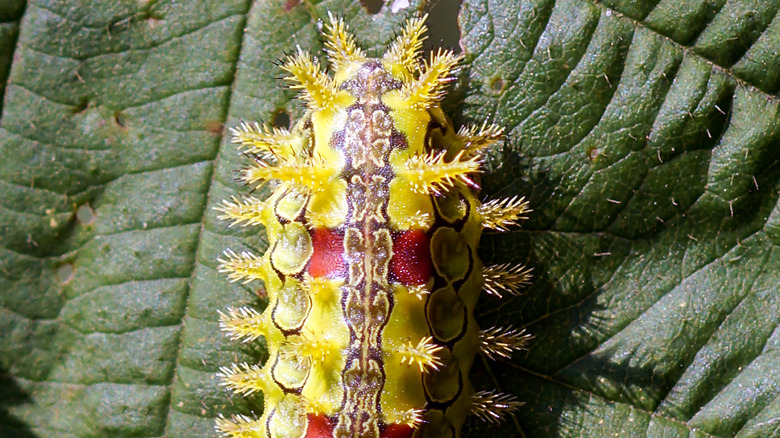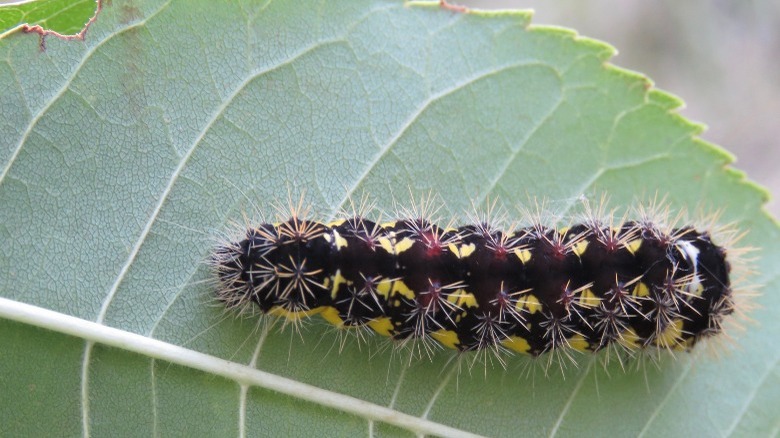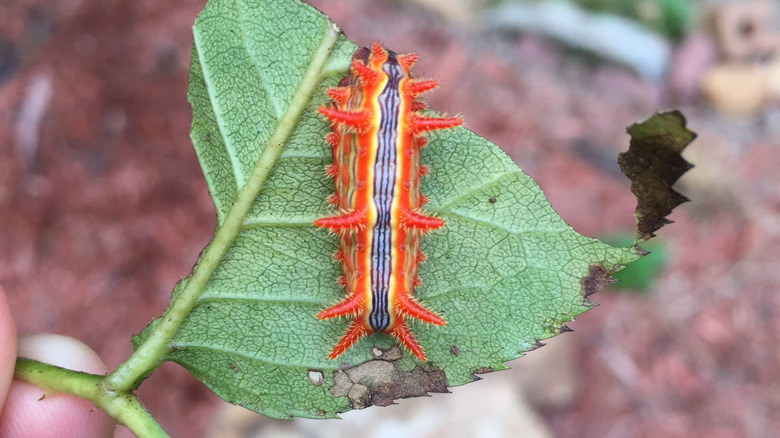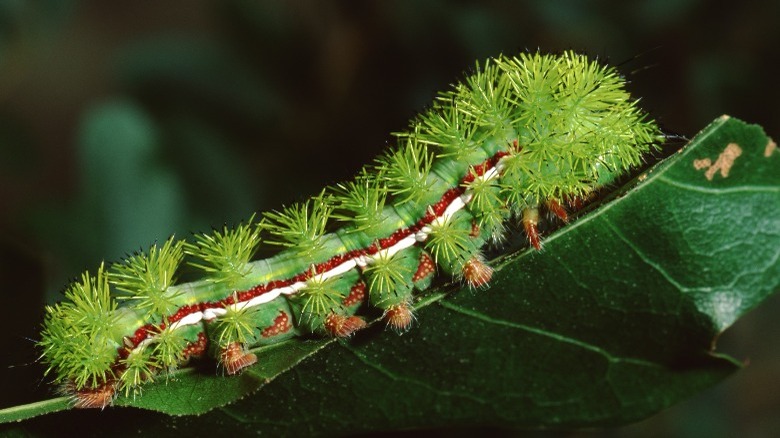Pesky Poisonous Caterpillars To Watch Out For In Your Garden
Some things are learned the hard way, like wearing gardening gloves to protect yourself from poisonous caterpillars when tending to outdoor plants. Brittanica explains that not all fuzzy moth larvae are toxic, but some sting — and it can hurt. Poisonous caterpillars are found in different parts of the globe, come in various sizes and shapes, and have wormlike bodies.
National Capital Poison Center claims that most caterpillars will not hurt you, but most have prickly hairs called setae. And while some caterpillars are covered in it, others have less. Setae ends are detachable and can get embedded in your skin. If you've never heard of "urticating hairs," Amateur Entomologists' Society defines them as barbed hairs that function as defense mechanisms for certain arachnids, moths, and butterflies. The urticating hairs (setae) on venomous caterpillars are connected to toxin-producing glands inside their bodies. The setae can detach, blow off in the wind, and get into your clothing, eyes, and skin. Caterpillar stings are not commonly known to cause poisonings in the United States. Still, if venomous setae get into your skin, Outforia posts that this can cause allergic reactions, pain, or irritation.
So call them caterpillars or moth larvae, but watch out for these pesky insects when working in your garden. And to prevent stings, remember to wear a good-fitting pair of gardening gloves to shield you from these tiny invaders. Here are what certain poisonous caterpillars look like and where they hang out.
Be warned about the spiny buck moth caterpillar
Louisiana State University's College of Agriculture (LSU Ag Center) describes the dangerous spiny buck moth caterpillar's habitat as Maine to Florida and extending out towards eastern Texas. The spiny buck's favorite tree is oak, but it also enjoys wild cherry trees, willow trees, and rose bushes. These caterpillars measure 2 to 2.4 inches and are distinguished by their small, white spots and red-colored heads. The University of Kentucky College of Agriculture, Food and Environment adds that the spiny buck moth caterpillar is brown to purplish black, but claims that the spots are yellow. When this toxic caterpillar reaches maturity, its body becomes covered in branched, black spines.
If you live in this caterpillar's habitat, be on the lookout: Hong's Landscape and Nursery advises that they congregate (and feed) on leaves and tree branches and can fall from them. According to LSU Ag Center, once you are stung by one, the pain is immediate, followed by redness, swelling, and itchiness. Some people are allergic to the stings, so it is crucial to watch for anaphylactic reactions. The symptoms should lessen after eight hours, but the raised welts can last up to a week. If one lands on you, University Medical Center New Orleans suggests carefully removing it with a credit card or a stick. Any visible spines can be removed with tape or a pair of forceps. Otherwise, they will fall away on their own after a few days. Apply ice packs for pain and swelling, and cover the area with a home remedy lotion of baking soda and water. You can also use hydrocortisone cream, ibuprofen, and oral antihistamines for the symptoms.
The giant silkworm moth caterpillar is hostile
These unusual-looking caterpillars live far away in Brazil and a few other South American countries. And according to Ohio State University, they like to hang out on the bottoms of tree trunks. These creepers are dangerous: The venom can cause hemorrhaging and other lethal symptoms like kidney failure. This source also writes that the caterpillar can be deadly. And since many of the stings occur in rural areas and are not reported, the number of incidences is underestimated.
There is more than one kind of giant silkworm moth caterpillar, and Ohio University points out that the Lonomia obliqua form has the strongest venom. Kaieteur News posts that L. obliqua's deadly venom has led to many deaths, particularly in southern Brazil. These caterpillars caused an epidemic in Rio Grande do Sul, with reports of gangrene and hematomas. If you happen to get stung by one of these, National Capital Poison Center recommends contacting a poison control agency or seeking immediate medical help.
The saddleback caterpillar will sting you
According to the University of Florida Entomology & Nematology, the nasty saddleback caterpillar can be found throughout New York and Massachusetts down to Florida and out to Kansas, Texas, and Indiana. Like other dangerous insects, saddlebacks have markings that warn predators of their toxicity; Brittanica defines aposematic as a coloring that warns predators of danger. The saddleback's body is slug-like in shape, with bright green middle sections and darkish brown ends. The green part can also have a brown, white-edged marking in the middle, and its legs are hidden beneath its belly. Both of the saddleback's dark brown ends have protrusions (tubercles) that have lengthy, urticating setae.
Blount County Master Gardeners posts that these caterpillars got their name because the green section resembles a saddle. This slug caterpillar likes to spend time hiding under plant leaves and can seem cute at first glance, so be careful. The spikes are hard to remove, and doing so can release more of the painful toxin. The pain can be hard to handle and last for a few days.
If one of these little green monsters gets onto you, the Center for Urban Agriculture strongly advises against brushing them away or crushing them. It is best to use an object like a stick instead. The most common symptom of a saddleback sting is a rash that appears at the point of contact. After a sting, grab some transparent or adhesive tape, apply it to the affected area, and keep sticking it on and stripping it off to remove any embedded spines. Wash the area well with soap and water, and apply an ice pack. Other treatments include taking analgesics like aspirin for the pain, antihistamines for itching, and creating a baking soda paste for swelling and pain.
The puss caterpillar can be hazardous to your health
NPR claims that this urticating puss caterpillar resembles the Addams Family TV show's Cousin Itt, though it measures only about 1 inch. It is covered in innocent-looking hair but is considered one of the country's most venomous moth larvae. It lives in regions from New Jersey to Florida, and also in states heading west toward Texas. University of Florida reports that the adult version of this toxic caterpillar is the southern flannel moth.
The Fish & Wildlife Foundation of Florida explains that puss caterpillars are covered in orange hair, with toxic spines hidden beneath. Why is it called a "puss" caterpillar, though? Probably because its fur looks like what you see on cats. They usually measure about 1.6 inches (1.4 inches without the tail, and the Fish & Wildlife Foundation of Florida notes they can be yellow, orange, or brown since caterpillars change color as they grow.
If a puss caterpillar's hair gets embedded into your skin, Merck Manual shows that the reactions can vary from a painful, burning rash that lasts for an hour to nausea, swelling, and breathing issues. Try the tape trick for these stings to remove the hair (keep applying and pulling off the adhesive tape to get the setae out), wash the area with soap and water, and dry it with a hair dryer on a low setting. You can also use ice packs, baking soda paste, rubbing alcohol, and calamine lotion. If the reaction is severe, seek medical attention as soon as possible.
Beware of the hickory tussock caterpillar
These mostly white-colored caterpillars are native from Wisconsin to Illinois in the west and Maine to New Brunswick in the north, though they are sometimes found from Texas to Mexico (via PennState Extension). They are more often seen in the fall, and eventually develop into hickory tussock moths. They can be as long as 1.7 inches and can be seen foraging on hardwood deciduous trees like oak, maple, and elm. The stinging hickory tussock moth caterpillar has black and white setae, fluffy black tufts on its backs, and slim black projections on its back.
Tussock caterpillars are not poisonous or venomous, according to The University of Maine Cooperative Extension. Their prickly hairs can cause rashes on the skin, and children are more likely to develop the rash than adults. There are different kinds of tussocks, too, like the banded, spotted, milkweed, and white-marked tussocks. The rashes that these specimens produce are generally mild and only last a few hours. That hickory tussock's sting can lead to longer-lasting, severe rashes that require medical attention.
You can wash the setae away with soap and water. Use tape as described above for embedded setae, or try a pair of fine tweezers. Sometimes those hairs get swallowed or stuck in the eyes, which can trigger serious allergic responses. For milder allergic reactions, try topical steroids or antihistamines. And as with other kinds of caterpillar stings, it is a good idea to keep an eye on the affected area for about 48 hours.
The pine processionary caterpillar moves in formation
This moth larva is not found in the United States – Forest Research posts that it is native to the Middle East and parts of Europe. But since live plants are traded internationally, the pine processionary moth and its offspring have been relocated to areas like Paris, Switzerland, and the United Kingdom. They build white, silky nests and consume plenty of pine needles; both are signs of infestations.
Sanitas Health Plans describes pine processionary caterpillars as being 1.18 to 1.57 inches long and covered with bristles. These little larvae are orange-brown, and you might notice their blue bands as they are proceeding on the ground and along trees. SUNY Cortland adds that pine processionary caterpillars have a distinct way of moving about: They form lengthy lines (head-to-tail) and may sting anyone who tries to touch them. As they proceed along their trails, they lay down pheromones and silk that mark where they have been.
ScienceDirect warns that a pine processionary caterpillar's urticating hairs can cause rashes and allergic reactions in some people. In severe cases, respiratory problems can occur. Some people find relief with antihistamine creams, but medical help may be needed for serious reactions. AnimalWised warns that these caterpillars are also dangerous for dogs. So if you see that your pet has a processionary caterpillar in its mouth, try to remove it (wearing gloves) and wash out the area. When dogs swallow these caterpillars, vomiting should be induced. So if you live in this caterpillar's native place, you may want to avoid walking your dog in wooded areas. Pine processionary caterpillars are also dangerous for young children.
The slithery, spiny oak slug
These unpleasant characters have green bodies with yellow and red stripes running down both sides. Other distinguishing factors are its yellow spikes that stick out of the yellow/red lines and a blotchy, dark stripe seen in the middle of its body.
According to the Kansas State University Department of Entomology, spiny oak slugs belong to the slug caterpillar family. There are 30 in total, and some can be more rounded. And instead of having longer legs, slug caterpillars have suckers beneath their abdomens, so they move about in similar fashions to their namesakes. And while they're typically yellow and red, Kansas State University Department of Entomology adds that these caterpillars can have other colors like green, orange, or pink. They are about 0.79 inches (2 centimeters) long, and their stings are relatively mild.
The spiny oak slug is native to parts of the U.S. and Canada (via BugGuide). They are seen in deciduous forests north up to Minnesota, west towards Texas, and on the east coast, from Quebec and New Brunswick down to Florida. Their diet consists of fruit trees like apple and cherry, plus willow, oak, chestnut, and maple.
If you happen to come upon a spiny oak slug, resist the urge to interact with it even if you think it looks fascinating. Our Wild Yard posts that this caterpillar's venomous spines can cause a burning sensation that can lead to serious allergic reactions. This can happen from just touching it. If you experience redness or itchiness, apply hydrocortisone to the area. For more severe reactions, head to your doctor's office.
The smeared dagger moth/smartweed caterpillar
The dangerous smartweed caterpillar evolves into the smeared dagger moth, and InsectIdentification shows that this insect is found in most of the eastern U.S. and parts of Canada and Mexico. The dark-bodied smartweed is about 1.41 to 2..21 inches long. Minnesota Seasons claims this stinging caterpillar is usually seen from May through November. It is described as primarily black, with white spiracles (breathing pores). In between those spots, you can see inverted, V-shaped yellow or reddish blotches. Dagger moth larvae (the same thing as smartweed caterpillars) enjoy eating oak, birch, pine, and willow trees. They are not picky, though, and eat shrubs and grasses like clover, too. Living With Insects adds that smartweeds are generally found in areas with a lot of moisture, like wetlands.
The USDA advises against handling smartweeds since the spines can break off and release toxins into the skin. Dr. Kendria Holt-Rogers of the University Medical Center New Orleans states that avoiding caterpillars is best and suggests wearing wide-brimmed hats and covering the arms and legs with clothing for protection when around oak trees.
The beautiful but bad stinging rose caterpillar
There's the saying "a rose by any other name," but this doesn't apply to the stinging rose caterpillar; its name signifies precisely what it is. This specimen has a bright red body highlighted with blue-lined, white stripes running down its length. On each end, you see four brilliant yellow caltrop spines, plus two more projecting out from the middle. Also known as rose slug caterpillars, these insects become tan, brown, and green moths.
Unlike other slug caterpillars, the stinging rose does not have prolegs. Meadowia claims that prolegs have tiny hooks that allow slug caterpillars to grasp onto surfaces, anchoring them securely as they move. Arthropod Museum explains that rose slugs have one oval lobe on their bottoms, located in the middle — there are no hooks to be found.
Stinging rose caterpillars are native to the U.S., and BugGuide shows that the territory is from New York state to Florida and Missouri to Texas. The stinging rose caterpillar can be ¾ to ⅞ inches long. Of course, you may see stinging rose caterpillars on rose bushes, but also sycamore, apple, dogwood, oak, and cotton trees. Their favorite time of year is late summer; that is when you are most likely to see them out and about. Urban Wildlife Guide compares the stinging rose's appearance to candy but warns that those spines can cause rashes, so avoid them if you see them.
It's monstrous: The Io moth caterpillar
This moth larva ranges from yellow/green to blue/green in color, with distinguishing white-and-red stripes and bristly, venomous spines. Lemon Bay Conservancy reported that these creatures could sting, but the pain is mild compared to stings from honeybees and yellow jacket wasps.
The bright yellow, red-spotted Io moth certainly has a different coloring than its larva. The Missouri Department of Conservation explains that the latter can be orange when younger and yellow/green to blue/green as adults. And instead of red spots, the caterpillars have slim white-and-red stripes running down their sides. It has rows of large green setae running on the top.
According to The University of Florida's Entomology and Nematology, the Io moth's widespread territory includes southern Canada, eastern Mexico, and more than half of the eastern United States. Full-grown ones measure about 2 ⅜ inches, and they can be found on willow trees, elms, maples, and certain fruit trees. This is a partial list, by the way, so make sure you keep your eyes peeled for them if you have trees in your yard.
